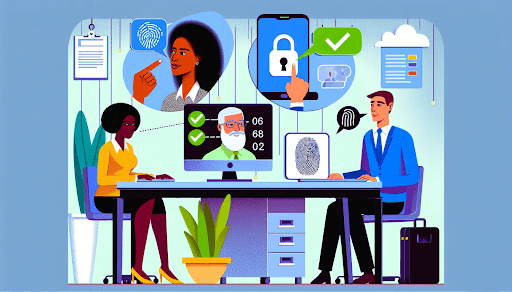In today’s highly connected world, social engineering senior officials have become prime targets for social engineering attacks. With access to confidential information and influence over critical decisions, these individuals are considered valuable assets for cybercriminals. How can we defend the top tier and ensure our organizations are secure from these insidious attacks? This blog post will delve into the high stakes of targeting senior officials, the tactics used by social engineers, and the strategies for identifying and counteracting attacks, as well as building robust defenses to protect our most influential leaders.
Key Takeaways
- Targeting senior officials carries a high risk for organizations due to access to confidential information, influence on decisions, and limited time for security measures.
- Organizations should use tailored security awareness training, robust access controls, and enhanced physical security protocols in order to safeguard against social engineering attacks targeting senior officials.
- Senior officials can protect themselves from manipulation attempts by verifying requests & communications, implementing verification protocols, and creating a security-aware culture among support staff.
The High Stakes of Targeting Senior Officials
Senior officials are particularly vulnerable to social engineering attacks due to their access to sensitive information, decision-making authority, and limited time available for security measures. These individuals are often targeted by common tactics such as phishing, pretexting, and baiting, as attackers aim to steal money or install malware on their systems.
Apprehending the reasons why senior executives are prime targets for cybercriminals, especially in the context of a cyber attack, helps organizations establish appropriate preventative measures. We will examine how access to confidential information, influence on critical decisions, and busy schedules can be exploited by malicious actors.
Access to Confidential Information
Senior officials often hold the keys to an organization’s most valuable data, making them attractive targets for social engineers. By gaining access to confidential information, malicious actors can exploit this data for their own gain or even use it as leverage in further attacks. One common tactic employed in phishing attempts against senior officials involves impersonating government agency IT departments to deploy malware on target computers or steal login credentials.
Implementing tailored security awareness training, robust access controls, and enhanced physical security protocols is an effective strategy to protect senior officials from such attacks. These actions aid in defending against various types of social engineering attacks and maintain the integrity of the organization’s sensitive information.
Influence on Critical Decisions
Senior officials wield significant decision-making power within organizations, making them prime targets for manipulation by social engineers. By exploiting human vulnerabilities, such as deception, persuasion, manipulation, and influence, attackers can manipulate individuals into divulging sensitive information or taking actions that serve their objectives.
Senior officials should prioritize the proactive identification and prevention of manipulation attempts in decision-making processes. They can do so by:
- Being cognizant of manipulation tactics
- Promoting open and transparent communication
- Considering multiple perspectives
- Completing thorough research and analysis
- Constructing clear decision-making processes
- Fostering a strong organizational culture
This vigilance helps protect them from attacks that aim to steal financial information or other sensitive data.
Exploiting Executive Schedules
The fast-paced lives of senior officials can make them more susceptible to social engineering attacks. Attackers exploit their busy schedules and reliance on assistants by employing techniques such as:
- Executive impersonation
- Phone phishing
- Compromised social media accounts
- Whaling
- Hobbies and interests exploitation
These tactics capitalize on the need for rapid communication and the delegation of tasks, allowing attackers to gain access to sensitive information or systems.
Senior officials can minimize the risk of such attacks by:
- Rigorously verifying the legitimacy of requests and communications
- Implementing strict verification protocols
- Fostering a culture of security awareness among support staff
These measures can help protect executives from targeted attacks.
The Arsenal of Social Engineering Tactics
Understanding the various tactics employed by cybercriminals is a key defense against social engineering attacks. These tactics often target senior officials, aiming to exploit their vulnerabilities and gain access to valuable data or influence critical decisions. In this section, we will discuss a specific social engineering tactic, along with common social engineering tactics, such as spear phishing, whaling, and quid pro quo.
Grasping these tactics enables senior officials and their organizations to pinpoint potential threats and put suitable countermeasures into action. By staying informed of the latest methods employed by social engineers, executives can reduce their likelihood of falling victim to these attacks and safeguard their organization’s assets.
Spear Phishing Attacks Against Leadership
Spear phishing is a targeted form of phishing that focuses on high-value individuals, often senior officials, using personalized messages to encourage them to reveal sensitive information or perform actions that benefit the attacker. This highly personalized approach makes spear phishing more challenging to identify than typical phishing campaigns.
Detecting spear phishing attacks involves senior officials:
- Examining the sender’s email address and name, looking for spoofed email addresses
- Assessing the email format
- Confirming legitimacy via a phone call
- Scanning shared links and attachments for any potential malicious activity
By being aware of the tactics used in spear phishing, executives can reduce their risk of falling victim to these targeted attacks.
Whaling: Big Fish, Bigger Risks
Whaling is a type of spear phishing that specifically targets high-profile executives and VIPs, using highly personalized messages to trick them into revealing sensitive information or performing actions that benefit the attacker. These attacks often have significant consequences, such as financial losses, reputational damage, and legal ramifications.
Senior officials need to be aware of the tactics employed in whaling attacks. By staying informed of the latest methods and remaining vigilant in verifying the authenticity of communications, executives can minimize their risk of being targeted and protect their organizations from the potential damage caused by these attacks.
Quid Pro Quo: A Tempting Trade
Quid pro quo social engineering involves offering something desirable to the target in exchange for information or access. Attackers often target senior officials by building trust and exploiting their vulnerabilities in these exchanges. A study revealed that 90% of employees yielded to the promise of a cheap pen in exchange for their password, demonstrating the effectiveness of this tactic.
To defend against quid pro quo attacks, senior officials must be aware of the psychological principle of reciprocity, which drives individuals to reciprocate when something is provided to them. By recognizing this principle and the tactics used by social engineers, executives can better protect themselves and their organizations from these attacks.
Identifying and Counteracting Attacks
Senior officials and their organizations need to be adept at recognizing and counteracting social engineering attacks. By understanding the various tactics used by attackers and implementing appropriate countermeasures, executives can minimize the risk of falling victim to these insidious schemes. In the following subsections, we will discuss how senior officials can identify deceptive communications and practice vigilance in verification.
These strategies can assist senior officials in safeguarding their organizations from the damaging effects of social engineering attacks. By staying informed and vigilant, executives can reduce the likelihood of becoming a victim and maintain the security of their organization’s assets.
Unmasking Deceptive Communications
The ability to identify potential threats in communications is a key skill for senior officials aiming to protect themselves and their organizations from social engineering attacks. Common red flags to look for include unexpected messages, urgency claims, and unknown senders.
To reduce the risk of falling victim to deceptive communications, senior officials should:
- Exercise caution
- Avoid clicking on links
- Verify the sender
- Look for red flags
- Educate themselves about common scams and social engineering techniques
By being aware of these indicators, executives can better protect themselves and their organizations from the damaging effects of social engineering attacks.
Vigilance in Verification
Senior officials can prevent social engineering attacks by implementing verification protocols for emails, phone calls, and other communications. By being attentive to the typical indicators of deceptive communications and verifying the validity of questionable communications, senior officials can more effectively guard themselves and their organizations against malicious actors.
Some common verification protocols include SPF (Sender Policy Framework), DKIM (DomainKeys Identified Mail), DMARC (Domain-based Message Authentication, Reporting, and Conformance), and BIMI (Brand Indicators for Message Identification) for emails, and establishing a trusted contact list, utilizing caller ID and call authentication, enacting multi-factor authentication, educating staff and colleagues, and regularly reviewing and updating protocols for phone calls. By implementing these protocols, senior officials can significantly reduce the risk of falling victim to social engineering attacks.
Building Defenses: Protective Measures for Executives
Organizations need to implement a range of defensive measures to effectively protect senior officials from social engineering attacks. These include tailored security awareness training, robust access controls, and enhanced physical security protocols. In the following subsections, we will discuss these strategies in more detail and explain how they can help safeguard senior officials against social engineering attacks.
Organizations can significantly reduce the risk of social engineering attacks targeting their senior officials by implementing these protective measures. As a result, executives can focus on their core responsibilities, confident that their organizations are well-protected against these ever-present threats.
Tailored Security Awareness Training
Senior officials can protect themselves and their organizations from these attacks by:
- Having a comprehensive understanding of common social engineering tactics, dangers, and indicators
- Providing senior officials with customized security training to help them recognize and resist social engineering attacks
- Teaching them common tactics and techniques used in social engineering
- Teaching them how to verify identities and sources
By implementing these measures, senior officials can better protect themselves and their organizations from social engineering attacks.
Essential components of a security awareness training program tailored for senior officials include:
- Customization
- Push and pull training
- Engagement
- Management involvement
- Formal education
- Metrics
By incorporating these elements into their training programs, organizations can equip their senior officials with the knowledge and skills they need to defend themselves against social engineering attacks.
Robust Access Controls
The potential damage caused by a successful social engineering attack targeting senior officials can be reduced by implementing strong access controls, such as multi-factor authentication and limited data access. Multi-factor authentication (MFA) is a security measure that provides an additional layer of authentication to access controls, combining multiple factors such as passwords, biometrics, tokens, and smart cards to increase security.
By restricting data access and employing MFA, organizations can lessen the potential harm that could be caused by a successful social engineering attack targeting senior officials. This not only protects sensitive information but also helps maintain the integrity of the organization’s systems and processes.
Enhanced Physical Security Protocols
The risk of in-person social engineering attacks targeting senior officials can be minimized by strengthening physical security measures, such as visitor policies and secure access points. By instituting measures that hinder or obstruct unauthorized individuals from gaining access to confidential areas or information, organizations can protect their executives from manipulation or deception.
To ensure executives are adequately protected, organizations should consider the following measures:
- Securing the building’s perimeter
- Conducting a comprehensive risk assessment
- Developing a security plan
- Deploying physical security measures
- Establishing protocols and procedures to handle security incidents
By implementing these measures, senior officials can focus on their core responsibilities, confident that they are well-protected against in-person social engineering attacks.
Summary
In conclusion, defending senior officials against social engineering attacks is a critical aspect of ensuring the security and integrity of modern organizations. By understanding the high stakes of targeting senior officials, recognizing the arsenal of social engineering tactics, and implementing strategies to identify and counteract attacks, as well as building robust defenses, organizations can safeguard their most influential leaders and protect their valuable assets. Stay informed, stay vigilant, and stay secure.
Frequently Asked Questions
What type of social engineering targets senior officials?
Whaling is a form of social engineering targeting senior officials by sending them seemingly legitimate emails in an attempt to commit fraud.
What is social engineering in office?
Social engineering is the practice of manipulating people to gain access to confidential information and computer systems. It involves exploiting human psychology to deceive and manipulate victims into divulging sensitive data, granting access, or executing malicious actions.
What makes senior officials particularly vulnerable to social engineering attacks?
Senior officials are particularly vulnerable to social engineering attacks because of their access to confidential information, ability to make important decisions, and limited time to focus on security.
What are some common social engineering tactics used against senior officials?
Common social engineering tactics used against senior officials include spear phishing, whaling, pretexting, baiting, quid pro quo, and tailgating.
How can senior officials recognize and counteract social engineering attacks?
Senior officials should be aware of common social engineering tactics, implement verification protocols for communications, and practice vigilance to recognize and counteract social engineering attacks.















There are no comments yet